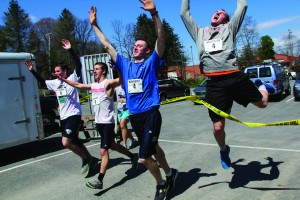Jonathan Bloom
Kerong Kelly
Writer
Throughout the week of April 8, Jonathan Bloom, journalist and author of “American Wasteland: How America Throws Away Nearly Half its Food (and What We Can Do About It),” organized and hosted several events on campus regarding food waste awareness and prevention.
Bloom’s most recent visit to the University was the third out of his four, week-long visits that are geared towards creating a campus-wide discussion about food waste. He is the O.V.W. Hawkins Expert-in-Residence, part of a lectureship series that was first established by the University’s Board of Trustees and funded by Hawkins, a former trustee. The lecturer’s focus is in the fields of public policy, politics and government.
Bloom’s visits are part of the University’s year long initiative on reducing food waste, eating locally and serving the needy, titled, “Feeding Our Hearts, Expanding Our Vision.” This initiative was the University’s response to the White House’s Interfaith and Community Service Campus Challenge, directed at colleges and universities to bring people together who are both religiously affiliated and who are not, in an effort to work on projects that will benefit the common good. After extensive research, Bloom estimated that nationally 25 percent of the food that is brought into the home is eventually wasted.
Bloom first started visiting college campuses about three years ago. He wanted to spread the word about the impact of food waste to the upcoming generation in order to promote awareness and possibly influence public policy.
“This generation has a disadvantage of growing up not knowing how to cook for the most part,” Bloom said. “The idea of wasting food is not seen as a problem or an issue. I’m trying to raise awareness on how much we do waste and to get people to see it as a problem, ethically and environmentally, and then to try to hopefully impact their behavior.”
Prior to writing his most recent book, Bloom contributed to publications such as the New York Times, Washington Post, Los Angeles Times, Boston Globe and Newsweek, to name a few.
Bloom, both in his book and in his lectures, emphasized the importance of eating locally. Bloom refers to the idea that locally grown food cuts down on the cost of transportation as well as the amount of food that is wasted throughout the distribution journey. Food purchased from farmers markets, though it may not have what Bloom calls the “supermarket model,” a reference to the perfect façade of supermarket food, is not thrown out simply because it is misshapen or discolored.
“Eating locally teaches you that taste is more important than appearance,” Bloom said.
In addition to lecturing in several classes from different areas of study, including The Ethics of Consumption, taught by Professor of Religion Maria Antonaccio, and Urban Economics, taught by Professor of Religion Carol White, Bloom organized a Zero Waste Dinner on April 10. The ultimate goal of this meal was to produce minimal to no waste. The dinner included student participation throughout all the stages–the shopping, the preparation and the cleaning. In addition to striving for no waste, Bloom also wanted to raise awareness about the importance of locally grown food. To do so, a group of students purchased food from the local Lewisburg Farmers’ Market.
A few students cancelled at the last minute, resulting in the donation of extra food to the local soup kitchen, Community Harvest, a hot meal program that offers food to the people of Milton and surrounding communities. A total of 12 students attended and aided in the preparation of the dinner.
In addition to the Zero Waste Dinner, Bloom facilitated the second food waste weigh-in of the 2012-2013 school year. Both weigh-ins were held between 11:30 am and 1:30 pm in the Bostwick Marketplace. According to Bloom there was a 33 percent reduction in food waste between the first weigh-in in October and the second weigh-in in April. In October 2012, 1,017 people ate lunch, creating 93 pounds of food waste or approximately 1.5 ounces per student. In April 2013, 917 people ate lunch, creating 55 pounds of food waste or 1 ounce per student.
“The food waste weighing served as a constant reminder of the careless amounts of food we throw away. It truly encouraged me to think about the staggering amounts of people who would do anything to have the food that we just waste,” Brandon Holden ’16 said.
Over the past few years, the University’s dining services have worked on initiatives to reduce the amount of food waste. In 2009, the tray-less initiative was launched in hopes of minimizing waste. Recently, students and members of dining services have worked together to put signage in Bostwick Marketplace in order to provide additional information about the University’s progress on food waste. According to John Cummins, general manager of resident dining for Parkhurst Dining Services, 37 percent of the food in Bostwick Marketplace comes from local sources.
“I think that the staff and myself have always been very focused on waste as it correlates to supplying different types of food to people and being conscious of what the volumes are,” Cummins said. “We really enjoyed working with Jonathan. I feel like he became a friend of ours during this time. I think he’s had an effect on the institution and on what we serve.”

